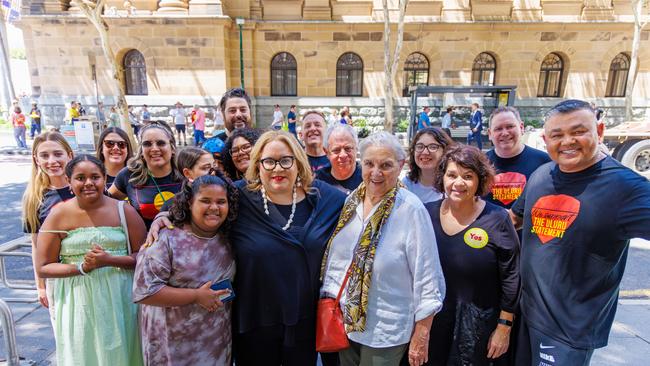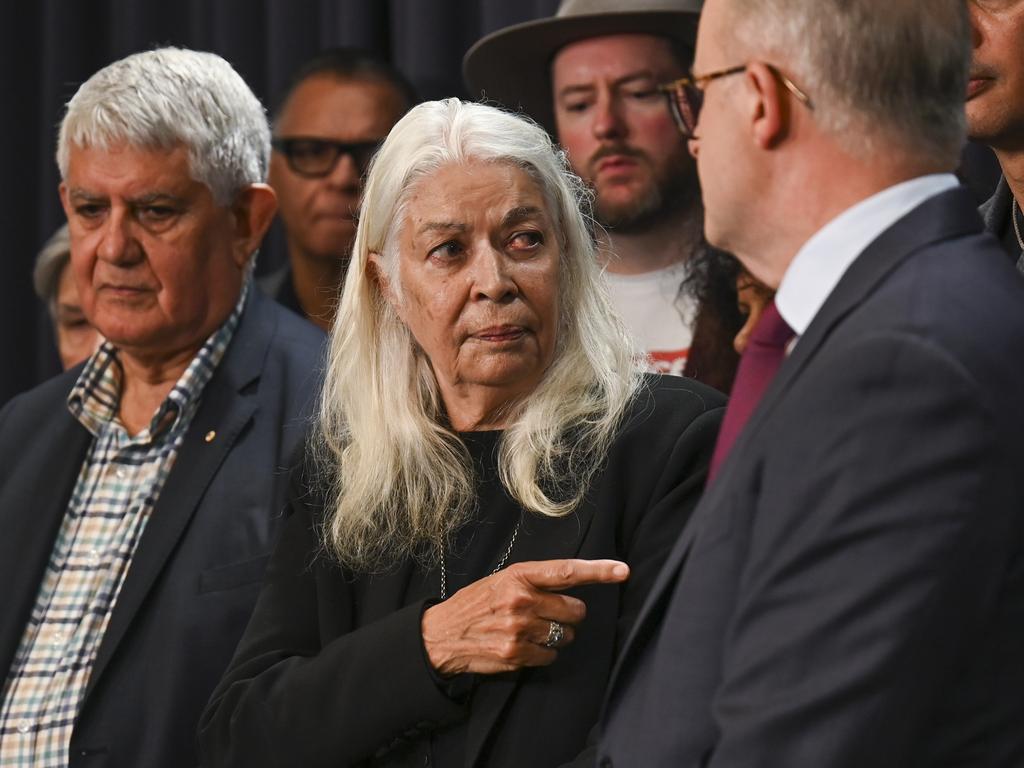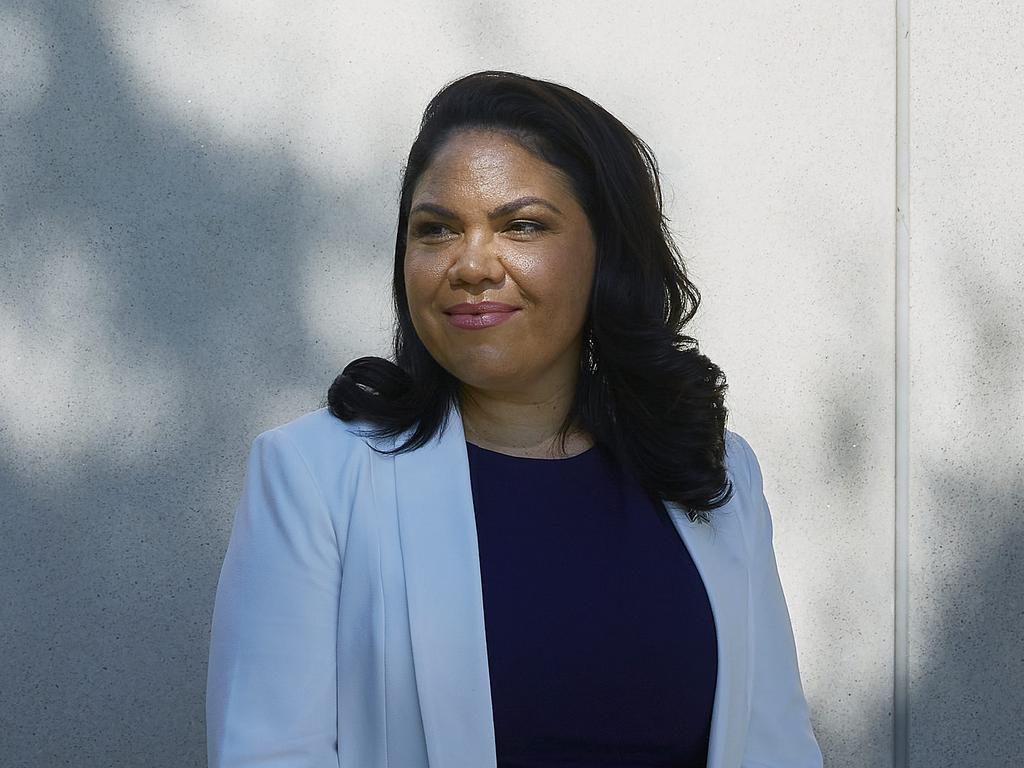How Megan Davis found her voice after the No vote
It has been eight months. Our leaders have withdrawn from media engagement and political engagement. But I’ve had a lot of time to think.

It wasn’t a campaign that began in 2022 when Labor was elected at a federal election; we had been working on the advocacy of constitutional recognition since 2011. Twelve long years. Eight government and parliamentary processes and 11 reports.
By the end of the campaign, it was a family affair. I spent much of my time in South East Queensland in my hometown of Eagleby and around Logan.
The night before, my youngest niece, Mimi – who had been named after me by my sister – asked her mum if she could sleep over with me. And in the morning she would come down to the Logan booths her mum was managing.
I remember waking up and usually Mimi disappears under the weight of her voluminous, cascading curls, but she was lying there and looked up at me and said: “Aunty, I am scared.”
The day after
I don’t know what time I woke up the day after the No.
I have spoken to so many mob, who the day after No didn’t want to leave the house. If they did, they felt sickened, hurt, rejected.
The one thing in my mind since Mimi the morning of the vote was: how will our jarjums (children) feel on Monday back at school?
The voting results show the youngest Australians were overwhelmingly Yes. These young Australians grow up in a world where their peers can recite the Aboriginal land they live on or learn on, they celebrate NAIDOC Day and Mabo Day. In kindy and primary, so many little Australians learn Aboriginal words and languages.
So many jarjums went to school on Friday belonging to something and returned on Monday feeling like they didn’t belong.
It has been eight months. Our leaders have withdrawn from media engagement and political engagement. But I’ve had a lot of time to think about the referendum, and yarn about it, and feel better placed to speak on it now. So, my NAIDOC remarks here are in the form of a letter to Mimi (who is at school).
Dear Mimi,
The vast majority of Indigenous people saw the merits of the voice.
Some said because it didn’t veto the Australian parliament and by default the Australian people, it wasn’t a substantive reform.
But they were in a very small minority of our people even though their voices were loud.
Our polling suggested the proportion in support was 83 per cent, and this was verified in the polling data from the referendum. In remote and regional areas, the Yes vote was over 80 per cent in most ballot boxes.

In some of Australia’s most remote areas, the vote was extremely high. Wadeye recorded 92.1 per cent Yes. In Maningrida, it was 88 per cent Yes. And in Tiwi Islands the vote was 84 per cent.
These results are significant as these towns have had many challenges and experience some of the most disadvantage, as well as being extremely remote.
They must have felt awfully remote on the night of October 14.
Of the 20 remote polling booths in the Northern Territory only one recorded a No.
This is important information for all Australians.
We knew from our own research going into the referendum that despite what some politicians and the news media would have you believe, the majority of mob supported the establishment of a voice to parliament.
Think for a moment about those identities who insisted First Nations people didn’t want a voice. The prominence they were afforded in the campaign, and how wrong they were: this is what Aboriginal affairs is like every day.
Voice is a powerful thing for human beings. It empowers. It dignifies. That it is why it was overwhelmingly popular among Indigenous people – and there can be no doubt about that.
The starting place for the 2023 referendum, for our people, is that it was a resounding Yes.
But it wasn’t just popular with mob. There is another mob that was identified that night. We discovered 6.2 million friends that we didn’t know we had; 6.2 million people is a movement – any way you want to measure it. And these were not votes placed out of fear, or falsehood. These were votes placed with pride, and positivity.
All of our research since the referendum suggests that these voters remain committed to the cause – they are tremendously proud of their Yes and they are staunch in their support – and that’s something we must build on.
Why the No?
So Mimi, you must be wondering why did 60 per cent of Australians voted No.
I won’t oversimplify. The media loves to latch on and identify The One Thing that tilted voters to the No camp. But all of our analysis indicates that there was no one reason. The reasons were many and varied. It is worth noting that we’ve had to do our own analysis to arrive at these conclusions – the media and government have done next to nothing as far as a post-mortem goes.
Was racism at play? Undeniably there was an element of it, but racism alone does not explain October 14. Was it Peter Dutton’s fault? He didn’t help. Neither did David Littleproud when he came out against the voice before he even knew what the proposal was.
But we can’t be sure that bipartisanship would have changed the outcome. Obscuring everything was a thick cloud of misinformation and disinformation. Throughout the campaign lies spread from both ends of the political spectrum.
Politicians and opportunistic zealots got involved and coloured the national conversation in a way that was divisive.
Then they sought to brand the idea itself as divisive. Imagine that, Mimi. Our people conceived of an idea to extend an olive branch to the rest of Australia. How can an olive branch be called divisive? How can someone who rejects an olive branch claim to be motivated by unity? It felt like a bad dream.
But it was not one thing. Rather, it was a cocktail of negative influences – racism, politicisation, disinformation, and let’s not forget plain old inertia and fear of change.
We continue to conduct in-depth research into the makeup of No. We can’t shy away from it, even if what we unearth is unpleasant.
I remember the day after the referendum – I did get out of bed eventually – in the evening. And as I walked to dinner cutting across the Queen Street Mall, I had a baseball cap on and refused to make eye contact. I could not quiet the voice in my head, reminding me relentlessly: He probably voted No. She probably voted No.
I am told many mob felt the same way, especially those who grew up and work in small towns with loads of non-Indigenous community people and interactions. Many could not reconcile those daily interactions and coexistence with No.
But then I remembered I was in Brisbane in a seat that screamed and voted Yes.
Where to from here?
Australians in 2023 voted No to enshrining an Aboriginal and Torres Strait Islander voice in the Constitution. They didn’t vote No to truth-telling. They didn’t vote No to agreement making. The No doesn’t mean a legislative voice is off the table. And the No was not a No to constitutional recognition.
Our research this year shows even No voters saying that the loss in the referendum does not extend to all things in Indigenous affairs.
This is surely the new goal upon which we must refocus our efforts.
The path to meaningful constitutional recognition for First Nations people has been a long one, and now that road has gotten a little longer. But it will continue. We will continue.
We know full well that we live in an unforgiving climate: the political landscape is fractious, both here and abroad. The effectiveness of Indigenous policy seems to be at historic lows – which is really saying something. The penalty for lying in the political arena also seems to be lower than ever. Trust in institutions is heavily eroded – both private and public.
Social justice movements the world over are struggling against the tide of “anti-wokeism”. Social media is engineered to marshal all of our attention and point it toward things that outrage us and pit us against one another.
These headwinds are significant, but despite these challenges we’re staying true to Uluru. I believe in the enduring importance of Aboriginal and Torres Strait Islander peoples being recognised in the Australian Constitution.
People ask me all the time, why constitutional recognition? Why must you be represented in the document that is the hardest to change?
The answer is embedded in the question. We ought to be recognised in that document precisely because it is the most important in the land. Because it is so hard to change. Once recognition is written into that document, it can’t be taken away – like so much else that has been introduced and then taken from us.
If we accept recognition in some less important way, we are conceding that we are not that important. We are important.
And constitutions are important. They are an effective tool for ensuring citizens flourish. They provide the material conditions for a dignified human life.
And they – constitutions – are not immovable. When we strip away the fear of change and the lies and the confusion, these are documents that are designed to evolve and improve.
Australia’s Constitution is a good one. We are a highly functioning liberal democracy. It provides the material conditions for a dignified human life for almost all Australians. We need only fix its one glaring hole. First Nations people belong to our own country, we want to belong in our own country. We have the same ambition for all Australians – for all of us to belong to and belong in our own country.
This isn’t about deepening any sense of us and them. We want to walk arm-in-arm into a future where we tackle the nation’s great challenges together. Celebrate its wins together.
This spirit was lost in the debate.
Young people voted Yes overwhelmingly. Their advocacy bodes so well for the future of our movement and our people – I draw great hope from them. That next generation will be a huge asset as we seek to change the state of Indigenous policy in this country.
Better outcomes for First Nations were needed urgently before October 14, and are certainly urgent now. Listening to us has to help.
The Productivity Commission report published earlier this year was scathing about bureaucratic processes in the Indigenous policy space. It’s a lengthy report but I’ll share you some of the best worst bits: “Overall, the commission’s engagements with over 130 Aboriginal and Torres Strait Island organisations have not identified systemic change in when and how decisions are made, indicating limited progress in governments sharing decision-making.”
It goes on: “Despite pockets of change, the commission heard many examples of consultation that did not go far enough. Words like co-design and partnership are frequently used but often turn out to be empty promises with little practical effect.”
And this: “The commission heard that engagements can still feel tokenistic as if they are being conducted to tick a box when the particular policy program has already been decided upon. This was often demonstrated by the timing of engagement, with governments engaging too late in the policy or program development cycle giving unrealistic timeframes for meaningful community input, and providing limited transparency on how the input has shaped policy decisions.”
The commission also found that while governments have demonstrated a willingness to partner with Aboriginal and Torres Strait Islander people, they still largely retained power over key decisions, including whose voices are incorporated and how investment decisions are made.
It’s damning stuff. But when the report was released, what was the reaction? Tumbleweed.
Even though the Productivity Commission validated all of the reasons the enshrined voice was critical, the media caravan has moved on. Perhaps they think the public’s appetite for matters Indigenous was exhausted in 2023.
I’m not sure if that’s true. What I do know is that tackling these issues is something we can’t do alone. If these goals aren’t shared by all Australians, meaningful change is unlikely.
In achieving that sense of shared purpose, all the academic works point to the concept of belonging as crucial. Its most lucid description is in Belonging without Othering by John A. Powell and Stephen Menendian.
Forgive me, Mimi, as I get into the academic weeds a little.
Powell and Menendian note that while egalitarian and other social justice movements can improve material conditions and the standing of marginalised groups in society, they tend to engender backlash, amplify polarisation and further fragmentation.
This book ultimately argues on behalf of a “belonging” paradigm and framework as the only one that has the potential to overcome these dynamics and reweave the social fabric. The problem of non-belonging may be most acutely felt by marginalised and “othered” groups, but it is experienced by superordinate and high-status groups as well.
Across societies, seemingly record numbers of people of all backgrounds report loneliness, despair, isolation and sense disconnection and dislocation or simply bewilderment. A “belonging” paradigm is attentive to both the problem of “othering” and the various crises of identity, resentment, and backlash that exacerbate it.
There are some big words in there – academics love a paradigm. But the book offers a simple example of how it might work in the real world. Powell and Menindian have suggested that the BLM movement in the US might have made greater inroads if it were known as Black Lives Matter Too.
This framing may have nipped in the bud the perception that this was one racial group trying to prevail over another. Out-group hitting back at in-group. Those sentiments gave rise to All Lives Matter, and the two factions remain at loggerheads. We’ll never know if those extra three letters would have set BLM on a more fruitful trajectory. But it’s worth pondering.
In the social justice sphere there is a tendency to romanticise “the fight”. But it could be that when we’re fighting, we’re losing. When we’re fighting, we’re not changing minds. And surely that’s the only way to win.
If we can cultivate this sense of belonging, then this isn’t a First Nations issue, this is an Australian issue.
Of course, that was at the core of the Uluru statement and remains so. Its sentiment about walking together for a better future was a nod to the fractious political environment. It was about engaging ordinary Aussies on the reasons change is needed.
During the Uluru Dialogues and at the national convention our elders, our gerontocracy, said: Let’s focus on the things we have in common, as Australians are born on Aboriginal land, some arrive for new beginnings in Aboriginal land, or seek peace from persecution on Aboriginal land. Australians live here, work here, have children here, die here. We are all tethered to this country.
The research shows that the primary reason for the No vote was that people didn’t want race in the Constitution. Guess what? It’s already in the Constitution. It dominated the discussions for our Constitution in the 1890s and it shaped the laws contained therein – laws of exclusion based on race.
Not everyone sees that – so we simply need to do our best to convey it. Shaming has no place in this effort. Many Australians have had quite enough of the left telling them they are ignorant or bigoted. It’s an approach that yields nothing and persuades no one.
We need to learn how to come together and motivate one another and push for progress without alienating those who aren’t – yet – on our team. The insularity common to so many activist movements is unhelpful. And righteousness is even worse.
We need to rise above the mudslinging of the political arena.
Mimi, this has been a long letter. That’s a downside when your Aunty is a law nerd. But I wanted to record for you my reflections on this moment. And recording what we feel and our version of what happened is important.
Someone remarked the other day on radio that Aboriginal leaders have retreated from media and political discourse after 2023.
But it’s time we tell our stories.
There’s an old African proverb that says: The hunter always tells the story of the hunt, never the lion. Well, Mimi, it’s time for the lion to roar.
Love, Your Aunty
This is an edited extract of the NAIDOC Week keynote lecture delivered by Professor Megan Davis at the University of Queensland on Wednesday. Professor Davis is pro vice chancellor society, UNSW Sydney.



The night before the voice referendum, we were all nervous.